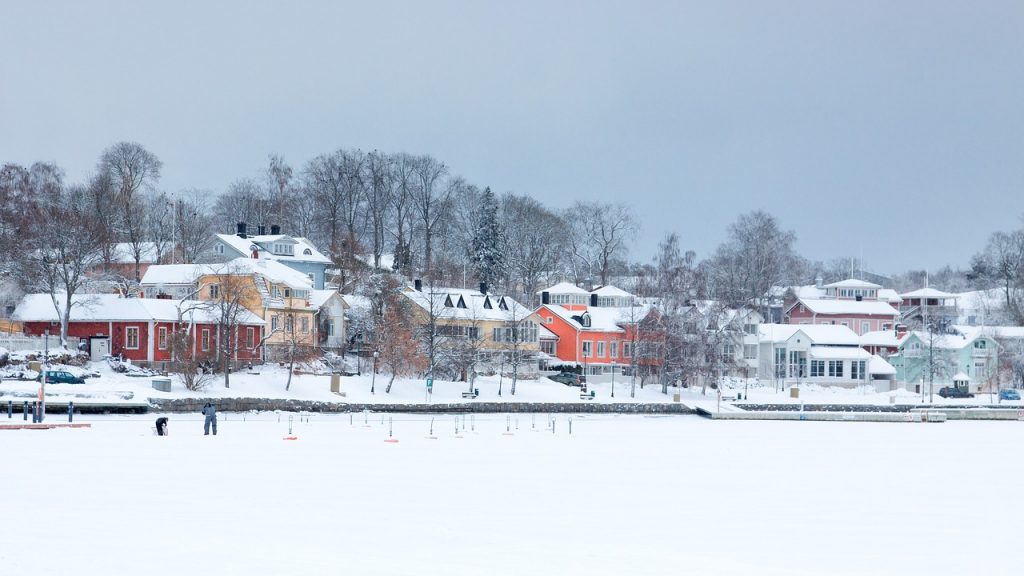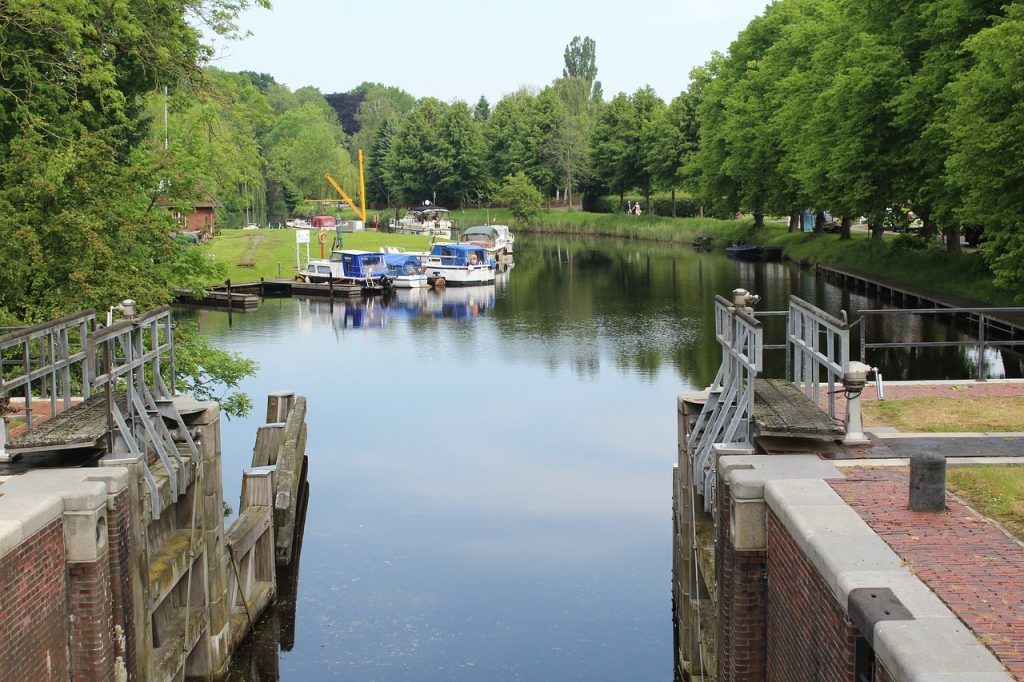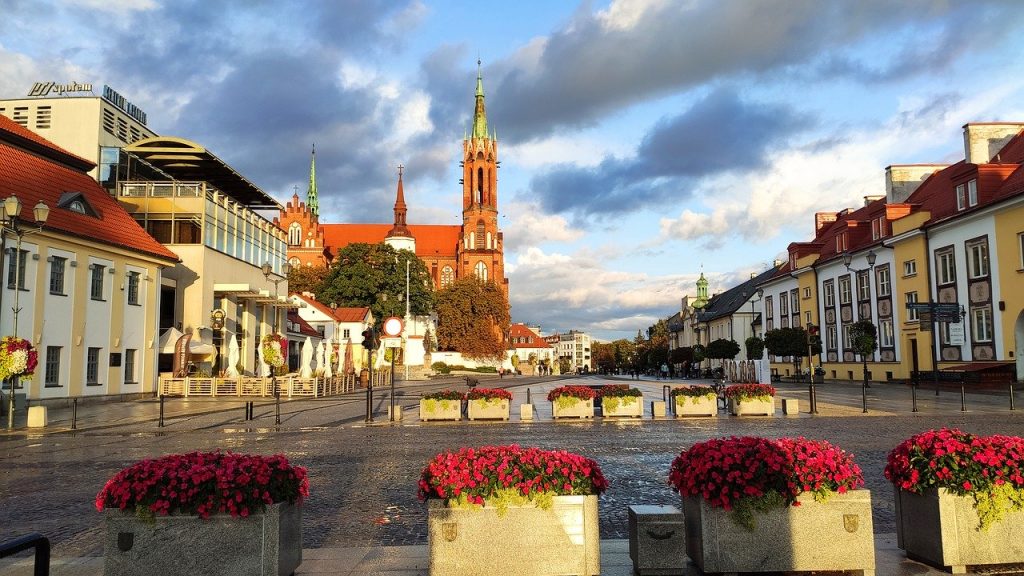Ryn – history
The oldest information about Ryn, or rather the Teutonic castle that gave rise to the settlement and the later city of Ryn, comes from the chronicle of Wigand of Marburg from 1377, and the castle was certainly completed that year. Some sources say it happened in 1376, and archaeological work suggests the possibility of dating much earlier. It should be remembered that we can deal here with two different structures – the original, made of wood and clay, and the later, proper – made of stone and brick.
The Teutonic Knights built castles at a short distance from each other (approx. 20-30 km) so that important messages could be transferred efficiently and quickly on horseback. Strategic considerations were also important. Often, when planning a site for construction, the presence of lakes and topography were used.

The Ryn Castle was built on a hill that was a narrow isthmus between two lakes, one of which was a natural moat. The castle complex consisted of the proper castle and the outer ward located to the east. The building housed residential, utility rooms and warehouses. A two-story wooden porch ran around the inner courtyard, from which one entered. The ground floor, without windows in the outer wall, served as a basement. The main, most representative rooms: the chapel, chapter house (dining room), refectory (meeting and council room) – were located on the first floor, while the second was used as a granary. The outer ward housed stables, barns, a blacksmith’s shop, etc. The basic fortification element of the castle building were external brick walls with small windows. The defensive function was fulfilled by a porch (running under the roof, on the outer walls), from which it was possible to fight off attacking enemies with hot tar or arrows from a bow, crossbow, or later – firearms.
In 1393, Ryn became the capital of the commandry. The first commander of Ryn was the mayor of Tczew, Fryderyk von Wallenrod. A convent resided in the Ryn castle. According to the assumption, it should consist of a commander, twelve knights and six priests. In practice, these numbers turned out to be very different. The commander, as the superior, managed the castle and the goods under its authority. He was responsible for collecting taxes and tributes, had judicial power, and above all he was the chief military commander of the district and head of the religious community. In addition to the military importance, the castle played an administrative and economic role, supplying the order, among others in fish, honey and wild game meat. The Ryn commander was in charge of the castles, among others in Lec (Giżycko), Szestno and Barciany. He had at his disposal a large ship, several smaller ones, fishing boats and the one built around 1412. ironworks. In the interests of economic development, numerous farms and estates were built (including the Sancti Nicolai farm – today’s Mikołajki). Sawmills and mills started to appear. The lakes surrounding the castle (Ryńskie and Ołów) were connected by an underground, brick channel over 170 m long (existing and functioning to this day! – it is one of the most interesting monuments of the Teutonic Knights). The natural drive of the castle mill was obtained by using the seven-meter difference in level between the lakes.
During the Great War with the Teutonic Order, the main task of the Ryn commander’s troops was to guard the area between the Piska Forest and Pregoła (this is where, it was believed, Polish-Lithuanian flags were to try to get to Malbork). In 1422, Ryn was downgraded to the rank of a prosecutor’s office. Despite its strategic location, thick walls and massive structure, the castle did not resist the siege of the rebels of the Prussian Union in the middle of the 15th century. The surviving Teutonic Knights were mercilessly drowned in the surrounding lakes and swamps. The castle returned to Teutonic rule after less than a year, recaptured by mercenary troops. The Treaty of Toruń of 1466 that ended the Thirteen Years’ War left Ryn within the Teutonic state. The commandry was restored here in 1468.
A settlement (outskirts) developed along with the castle, which gave rise to the future city. At the end of the 15th century, Podzamcze was granted the rights of a market estate, which contributed significantly to its development.
In the 16th century, Ryn became an administrative and settlement center. After the liquidation of the Teutonic Order, and thus also the Ryn commandry, the Starosty of Duchy of Prussia was established here. Hopes for further development of the settlement were dispelled by the invasion of the Tatars, who in the middle of the 17th century devastated the entire area, taking some of the inhabitants into jasyr and cutting the rest to the trunk.
Half a century later, the plague wreaked so much havoc that some villages were almost completely depopulated. The survivors left their homes, taking refuge in the nearby forests.
In 1723, Ryn received city rights. This was to resolve the impasse caused by past disasters and facilitate development. The arriving settlers were offered many privileges, incl. a free site was granted to build a house, covering a third of its construction costs, and free logging was allowed. In the mid-18th century, the authorities put the castle up for auction. From then on, until the mid-19th century, its private owners changed, and the building was passing from hand to hand, and it was falling into decline.
In the mid-19th century, a prison was built in the rebuilt castle. Four hundred and sixty-eight prisoners detained here were employed for heavy work, min. at the construction of the road to Sterławki Wielkie.
Almost until the end of the 18th century, Ryn was a Polish town. In the 19th century, a systematic and decisive Germanization campaign began. Settlers from Germany were brought in, restricting or even forbidding Poles to settle. In the mid-nineteenth century, the ratio of the Polish population to the German population was two to one, and during the plebiscite announced in 1920, not a single vote was cast for Poland …
In the interwar period, Ryn became famous as a health resort. There were six hotels in the city, numerous nightclubs, dance halls, bars, swimming pools and baths. You could come here by steamboats, postal buses or a narrow-gauge railway.
After the war, the castle was the seat of the town hall and other institutions for many years. Since 2001, it has been privately owned. Since 2006, it has been operating as a Congress and Leisure Center “Hotel Zamek Ryn”.
Ryn Castle
The castle in Ryn is the second largest Teutonic castle in Poland. Situated on a hill between the lakes: Ryńskie and Ołów, it towers over the city. It was built by the Teutonic Knights in the 14th century during the times of the Grand Master Winrich von Kniprode. In 1393, a commandry was established here. The first commander of Ryn was Fryderyk von Wallenrod. After the dissolution of the order in 1525, the castle became the seat of the starosty. In the 18th century it was put up for auction. From then until mid. In the nineteenth century, it changed hands, going downhill. A prison was established here in the 19th century. After World War II, the building was the seat of various offices and workplaces. Currently, beautifully restored since 2006, it houses the Masurian Congress and Leisure Center “Zamek Ryn”, and a luxurious, four-star hotel. Certainly, the castle in Ryn is one of the most beautiful and interesting examples of the proper development of historic historical buildings for tourist purposes. The former courtyard is now surrounded by four wings: Komturskie, Knight, Hunting and Prison. The courtyard itself has undergone great changes – it has been covered with a transparent roof and turned into a huge hall, where atmospheric events can be held that can accommodate up to 1000 people. The former refectory, where monks used to eat their meals, has been turned into an elegant restaurant serving exquisite dishes. Guests have at their disposal 164 rooms and apartments, conference rooms, a night club, bowling alley, fitness room, swimming pool, saunas, water jets, hydro massage. An interesting offer are also numerous cultural, artistic and entertainment activities: concerts, feasts and performances.
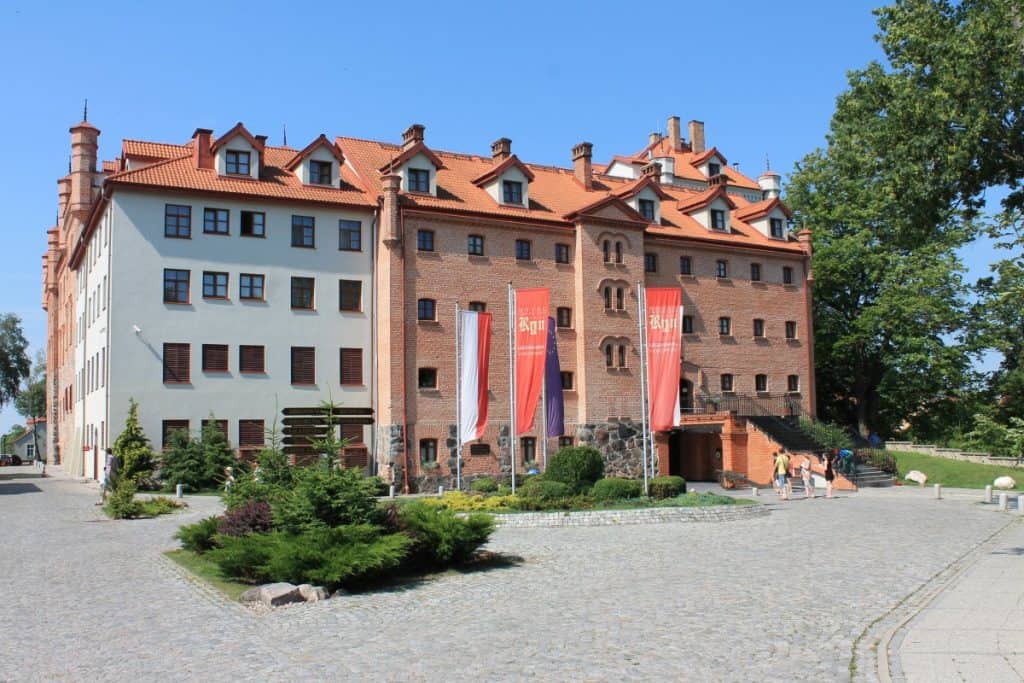
Watermill
Water mill – already in the times of the Teutonic Knights, the fact that Lake Ołów is located higher than that of Lake Ryńskie was used. The difference in levels is as much as seven meters over a distance of 170m. Thanks to the connection of the two lakes with a canal, the natural slope of the terrain was used and water was harnessed to power the castle mill. Water from the canal also supplied the castle well. The canal has survived for centuries, still exists today and is an interesting example of medieval engineering. In the 19th century, it was covered with field stone, it runs underground and is 170 cm high in the highest parts. A water mill was built at its outlet in the 19th century. The mill worked efficiently for many years and produced flour, competing with the windmill. After over a hundred years of work, it ceased to function in the 1980s. Over the next years, it deteriorated and fell into decline, passing into other hands of private owners. In the end, it became an ugly ruin, which was threatened with demolition (photos of the mill from several dozen years ago and the interior of the canal can be seen in the museum in Ryn, located nearby). Fortunately, in 2011 and 2012 the mill was beautifully restored and converted into a hotel and restaurant. Its interesting shape has already entered the surrounding landscape. Interestingly, the water still flows along the Ryn channel and, as it used to, flows out with a noise right next to the mill. It even turns the mill wheel, although this is only a tourist attraction. Inside, apart from the hotel and the regional restaurant, there is one of the few in the area – a regional shop. You can buy cold cuts from the castle in Ryn, cow and goat cheeses, tinctures, honey, preserves and many other delicacies.

Canals on the route of the Great Masurian Lakes
Canals on the route of the Great Masurian Lakes near Ryn – already in the medieval times, the importance of water communication on Masurian lakes was appreciated. In 1379, the Grand Master of the Teutonic Knights, Winrich von Kniprode, traveled by water from Ryn to Malbork. Masurian canals created a unique system of water routes between Węgorzewo and Pisz. The first designs for their construction were developed by Polish brothers Józef Naronowicz – Naroński, Samuel Suchodolec (Suchodolski) and Jan Władysław Suchodolec. In 1765, makeshift canals connected Lake Śniardwy with Lake Mamry. Their shores were reinforced with fascines, and the sluices were made of wood. There were six locks and ten bridges. The canals gradually became sandy and their exploitation ceased in 1789. Ultimately, the system of water connections was destroyed during the Napoleonic Wars. The Masurian canals took their present shape during the great public works in the years 1854 – 1857. Out of a dozen or so canals, as many as four are canals near Ryn: the Szymoński Canal (between Szymoneckie and Szymon Lakes – 2360m long). The Mioduński Channel (between the Szymon and Kotek Wielki Lakes, 1920m long). The Grunwaldzki Channel (between Lake Kotek Wielki and Tałtowisko, 470m long) and the Tałcki Channel (between the Tałtowisko and Tałty Lakes, 1062m long). Masurian canals are not only an interesting element of the landscape and a favorite place of anglers, they are primarily historic (hydrotechnical) facilities and an interesting example of solutions in the field of water communication.
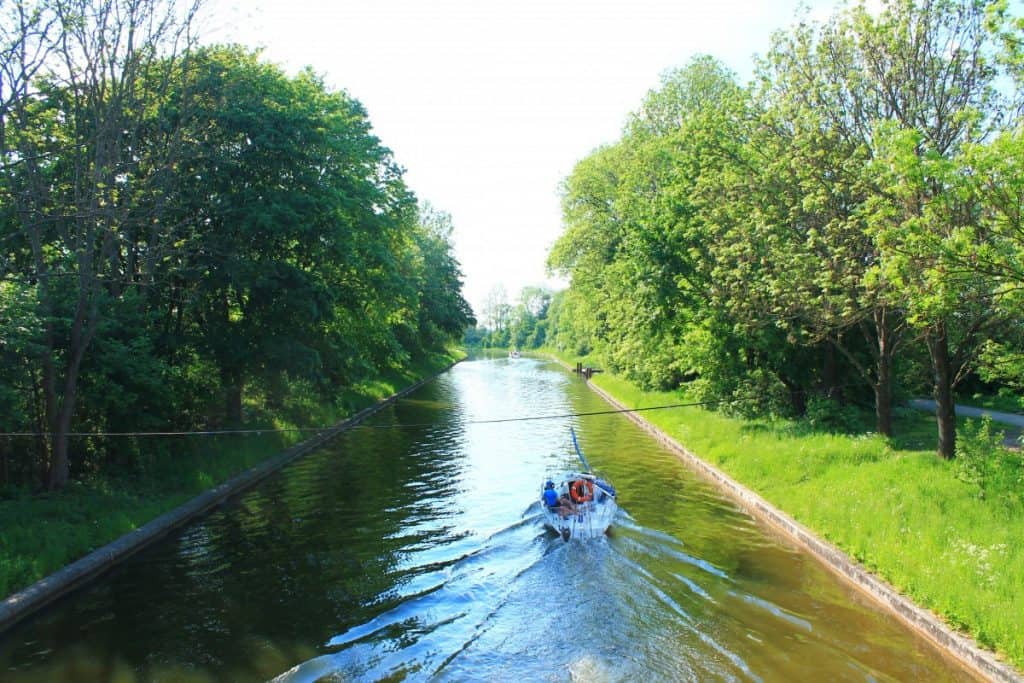
Ancient castles
Grodziska is a permanent element of the Masurian landscape. There are at least a dozen of them in the area. Not all of them are as visible and impressive as one of the most beautiful and, at the same time, the most characteristic – the stronghold located near the village of Jeziorko. They were used in the Iron Age (around the second half of the 1st millennium BC), and in the early Middle Ages. The stronghold was not permanently inhabited. One can definitely speak of its defensive nature, because it was a place of refuge for the inhabitants of a nearby estate in times of danger. The monumental, imposing hill is impressive, especially from a greater distance. Then you can see its greatness and beauty. For strategic and practical reasons, the Galindians, when building their settlements, took advantage of the terrain and the presence of lakes and forests. Maidan in the center of the stronghold, significantly bulged, is surrounded by a stone and earth embankment. In the past, the rampart was additionally reinforced with a wooden palisade. On the eastern side, where the entrance gate was located, its slight lowering is visible. During archaeological excavations, many items from different eras have been found here (clay vessels, stone tools, bronze products). Grodzisko is located about 900 meters south-east of the village of Jeziorko, several kilometers from Ryn. Its top offers a beautiful view of the surrounding area. Nearby, west of the village, there is “Wieżowa Góra” – the highest hill in the area (188m).
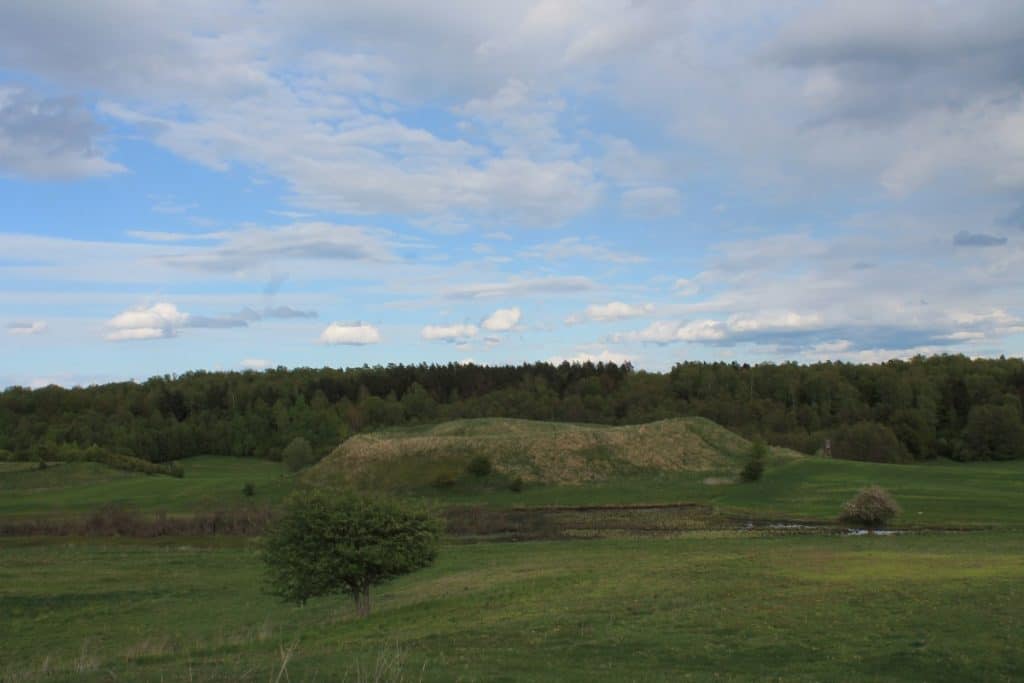
Ryńskie Lake
The shore of Lake Ryńskie – It is not known which of the views is more beautiful. The one showing the waterfront and the city panorama from the side of Lake Ryńskie, or the one from the waterfront to the lake and the surrounding hills. One thing is certain, the shore of Lake Ryn is certainly one of the most beautiful places in Masuria. Its uniqueness also lies in the fact that you can sail here from almost every corner of the Great Lakes Region. Tałty Lake, together with Ryński Lake, constitute the largest and longest lake in the area (20 km) and at the same time a branch of the Great Lakes Trail, which flows almost into the city center. The unusual charm of the Tałty and Ryńskie lakes, their varied coastline, numerous bays, peninsulas and islands and attractive camping sites encourage you to deviate from the main route and swim to Ryn. It is close to everywhere from the waterfront. To the shops in the city center, the Tourist Information Point, the castle, the museum and gallery in the Ryn Cultural Center, or the souvenir shop. In the new port, sixty yachts can moor at the piers (to which water and electricity are supplied). It is worth visiting the nearby, restored mill from the 19th century. You can not only eat well, but also shop in the shop with regional products. The Ryn quay is a favorite resting place for residents and tourists. The new promenade with benches, stylish lanterns, shelters and a fabulous view of the lake invites to walks.

The article comes from the official website of the city of Ryn.
